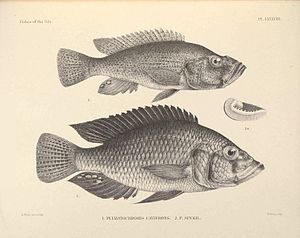Haplochromis spekii
| Haplochromis spekii | ||||||||||||
|---|---|---|---|---|---|---|---|---|---|---|---|---|

Haplochromis spekii (below), drawing from The fishes of the Nile by George Albert Boulenger , above: Haplochromis cavifrons |
||||||||||||
| Systematics | ||||||||||||
|
||||||||||||
| Scientific name | ||||||||||||
| Haplochromis spekii | ||||||||||||
| Boulenger , 1906 |
Haplochromis spekii is an extremely rare or already extinct fish species from the genus Haplochromis within the cichlid family. It is named after the English explorer John Hanning Speke .
features
Haplochromis spekii reaches a head-trunk length of up to 220 mm. The body height is up to 78 mm, the head length up to 82 mm, the snout length up to 32 mm and the eye diameter 16.4 mm. The mouth is horizontal or slightly sloping. The lower jaw protrudes a little. Eight (rarely nine) more or less strong gill leaves are arranged on the first gill arch. The flanks have 30 to 34 comb scales along the lateral line organ . There are 24 to 26 dorsal rays and 11 to 13 anal rays.
The coloration is only known from specimens preserved in alcohol. In the adult, sexually active males, the basic color is generally brown, including the entire head, both jaws and the gill membrane. An indistinct median lateral stripe runs behind the gill cover to the beginning of the caudal stalk. The dorsal fin is blackish on the basal half and transparent on the soft distal half with dark spots and spots. The caudal fin is yellowish on the distal third and otherwise blackish. The anal fin is slightly blackish. Four to five moderately sized neutral white eggspots are usually arranged in two rows or in an irregular row. The pelvic fins are blackish.
In the adult, sexually inactive males, the basic color is different, but always lighter than in the sexually active fish. The muzzle and jaws are darker than the flanks, which vary in color from blackish to light golden brown. The gill skin is blackish, but sometimes only in the area above the gill cover. The dorsal fin is dark, the skin flaps are black, and the soft part is often covered with closely spaced dark spots or spots. The color of the anal fin varies from blackish to yellowish. Two to five whitish-gray ocelles are arranged in two rows or an irregular row, as in the sexually active males. The pelvic fins are usually dark, but of varying intensity.
The adult and juvenile females are brownish on the top, head and snout. On the rear flanks, on the abdomen, on the chest and on the gill cover, the color changes into a silvery brown or grayish-silver. The gill skin is grayish. A weak mid-lateral band of variable depth and an irregular contour runs from behind the gill cover to the base of the caudal fin. An indistinct longitudinal stripe runs slightly above the upper flank line. All fins are brownish-yellow; the soft dorsal fins show dark spots. The caudal fin is brownish on its proximal two-thirds.
The immature males are colored similar to the females. With them, longitudinal stripes are more pronounced. Some specimens have faint traces of four to five vertical bands that cross the longitudinal stripes on the flanks. The pelvic fins are pale soot-colored.
Occurrence
Haplochromis spekii is or was widespread in the following areas in or in the neighboring waters of Lake Victoria : On the Ugandan side near Bunjako , in the Victoria Nile , in the Napoleon Gulf near Jinja , in the Buvuma Channel near Nasu Point, on the southern tip of Ramafuta Island, at Karenia near Jinja, in Pilkington Bay, in Thruston Bay and in Buka Bay. On the Kenyan side on the Kavirondo Golf near Kisumu , in Naia Bay, near Sagorony and in Ulambwi Bay as well as on the Tanzanian side of Lake Victoria near Majita, between Ghogorogo and the Isanga Rivers, in Speke Golf and in Capri Bay near Mwanza .
Habitat and way of life
Haplochromis spekii lives in the lower water layers and occurs both over hard substrates (rocks) and over soft soils. Most of the specimens were caught in protected areas with water depths between three and nine meters. The diet consists of fish, including smaller Haplochromis species, cichlids and cyprinids, and fish larvae.
status
Haplochromis spekii was last detected in 1967 in Lake Victoria and in 1992 in the Mwanza Gulf and Speke Gulf. In 1996 the species was classified as " extinct " by the IUCN . In 2006 this status was changed to “ critically endangered ”, as not all areas of the former distribution area have been sufficiently searched. The reasons for the disappearance of the species are the reenactment by the Nile perch ( Lates niloticus ), overfishing , sedimentation and eutrophication .
literature
- Peter Humphry Greenwood: A Revision of the Lake Victoria Haplochromis Species In: Bulletin of the British Museum (Natural History Zoology) , Vol. 15, 1967-1968
Web links
- Haplochromis spekii in the Red List of Threatened Species of the IUCN 2008. Posted by: JDR Bayona, 2006. Retrieved on 10 November, 2008.
- Haplochromis spekii on Fishbase.org (English)